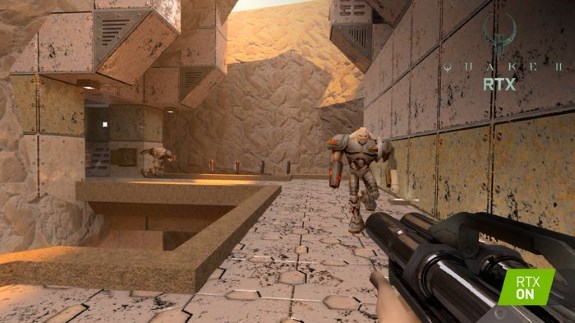
Posted on Monday, May 27 2019 @ 9:59 CEST by Thomas De Maesschalck
NVIDIA announced that Quake II RTX will be published on the GeForce.com website as a free download on June 6. This version of the game will include the first three single-player levels. Gamers who own a copy of Quake II will be able to experience the full game in RTX ON mode. To run the game, you will at least need the GeForce RTX 2060.

Quake II RTX is the world’s first game that is fully path-traced, a ray-tracing technique that unifies all lighting effects such as shadows, reflections, refractions and more into a single ray-tracing algorithm. The result is a stunning new look for id Software’s Quake II, one of the world’s most popular games, originally launched in 1997.
Quake II RTX includes the first three single-player levels of the beloved PC gaming classic. Gamers that already own Quake II can experience the whole game in its entirety, including multiplayer deathmatch and cooperative multiplayer modes, all fully path traced.
“Quake II RTX is an expression of our love and passion for PC gaming,” said Matt Wuebbling, head of GeForce marketing at NVIDIA. “By applying next-generation ray-traced graphics technologies and using the Vulkan API, we are able to share this PC classic with a new generation of gamers who can download and play it for free.”
“It’s rare that a PC game has the impact and longevity of Quake II, and seeing it reimagined with ray tracing 20 years later is something special for me,” said Tim Willits, studio director of id Software and one of the creators of the original Quake franchise. “Equally special is the relationship with NVIDIA, whom we have worked with since the early days of first-person shooters. Seeing how NVIDIA integrated modern features into this classic game is really exciting.”
Same Great Game, Stunning New Look
The visually stunning new look of the classic game is achieved by a ray-tracing technique known as path tracing, which traces light rays (paths) through the scene in a way that unifies all lighting effects into a single ray-traced algorithm. This elegant form of rendering is used in computer graphics in films but has previously been too expensive for games.
The lighting effects in Quake II RTX are so advanced they require hardware support for ray tracing, such as the specialized RT Cores found in the Turing™ architecture and NVIDIA GeForce RTX™ GPUs, to run in real time. The minimum specification for running Quake II RTX in real time is a GeForce RTX 2060 GPU.
New levels of realism seen in Quake II RTX include real-time, high-dynamic range time of day lighting, with accurate sun light and indirect illumination. Physically based materials are rendered accurately. For example, water and glass refract light accurately, emissive surfaces get dramatic soft lighting effects, surfaces deliver accurate reflections and light sources illuminate surrounding objects. Weapon model details and textures have also been increased, and an improved denoiser has been added to increase image quality.
Quake II RTX uses NVIDIA VKRay™, an extension that allows any developer using the Vulkan API to add ray-traced effects to their games. Building on Q2VKPT, a version of the game created by Christoph Schied using the open-sourced Quake II game engine, Quake II RTX is a pure ray-traced game that runs on a Vulkan renderer with support for Linux.
“Quake II RTX demonstrates that the Vulkan API with real-time ray tracing can be used to create stunning gaming experiences using some of the most advanced rendering techniques available to game developers,” said Neil Trevett, president of the Khronos Group and vice president of developer ecosystems at NVIDIA. “And, having Quake II RTX available as a free download makes it accessible to both Windows and Linux gamers everywhere.”

